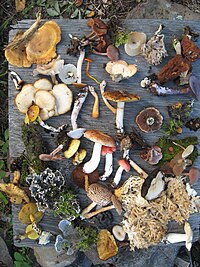
Photo from wikipedia
Maintaining species turnover across habitats is essential for biodiversity conservation. Thus, identifying drivers of community variation is important for conservation strategies. Here, we examine spider community variation along a Mediterranean… Click to show full abstract
Maintaining species turnover across habitats is essential for biodiversity conservation. Thus, identifying drivers of community variation is important for conservation strategies. Here, we examine spider community variation along a Mediterranean climatic gradient in Greece, characterised by a mosaic of vegetation. We quantified spider community composition in 22 sites including three different habitat types (grassland, shrubland, oak forest) along a temperature gradient. Community composition was assessed at the family and species (Gnaphosidae and allied families) level. We partitioned beta diversity into two additive components, turnover/balanced abundance variation and nestedness/abundance gradient. Permutational multivariate analysis of variance was used to assess the effects of habitat type, temperature, humidity and elevation on beta diversity. Results showed that different habitat types harboured distinct spider communities at both taxonomical levels. Turnover and balanced abundance variation of families and species were the largest beta diversity components. Turnover and balanced abundance variation of species but not families were significantly affected by temperature differences and the rate of compositional change was similar in grasslands and forests. We conclude that maintaining habitat heterogeneity in the area will conserve spider diversity and that future rising temperatures may potentially lead to species replacement and to changes in the chorological spectrum of the communities. Applying beta diversity partitioning at small spatial scales can offer valuable insights into climate change effects and sustain the development of appropriate conservation actions, especially in cases where temporal or coarser-scale distributional data are lacking. Given their sensitivity, ground spiders are good indicators of climate change effects on biodiversity.
Journal Title: Biodiversity and Conservation
Year Published: 2019
Link to full text (if available)
Share on Social Media: Sign Up to like & get
recommendations!